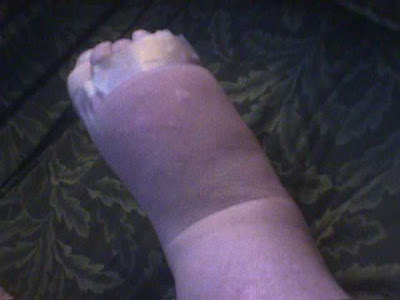 |
| graphic from Principles & Practice of Palliative Care & Supportive Oncology, 3rd Edition Difficult Pain Syndromes: Bone Pain, Visceral Pain, Neuropathic Pain |
Activated Glia: Targets for the Treatment of Neuropathic Pain
Summary of the Workshop Proceedings
The role of activated glia in the neuronal mechanisms of chronic pain was the focus of the workshop, Activated Glia: Targets for the Treatment of Neuropathic Pain, held October 8-9, 2010 and sponsored by the Reflex Sympathetic Dystrophy Syndrome Association (RSDSA). Goals for this workshop included approaching neuropathic pain disorders, complex regional pain syndrome (CRPS), and other chronic pain conditions from a new perspective; bringing together experts in glial cell biology and function, imaging, patient advocacy organizations, clinicians, and industry representatives to challenge current concepts of chronic pain; and, ultimately, developing a knowledge consortium to further the work of this workshop.
Presentations focused on the biology of glia, imaging of activated glia, new ways to attenuate the deleterious actions of glia. Donald Manning, MD, PhD, set the stage with an overview of glial activation and its implications in neuropathic pain disorders. Glia, which until recently were thought to be passive support cells for the neurons, now are considered an important link between the immune and nervous systems in inflammation and trauma. Therapies directed at activated glia hold promise for a new approach to intractable pain. To expedite the goal of developing new diagnostic tools and new therapies for intractable pain, it is important to allow the cross-fertilization of ideas to occur between preclinical and clinical researchers in venues such as this workshop. Dr. Manning cautioned, however, that any new developments in the treatment of chronic pain must also begin and end with the patient. If animal models do not hold up to patients’ experiences, their value in furthering clinical development is questionable.
Joyce DeLeo, PhD, described the evolving model of the synapse, the junction across which a nerve impulse, such as a pain signal, travels from one nerve cell to another nerve cell, muscle, or gland. Glial cells, including microglia, astrocytes, and oligodendrocytes, constitute more than 70% of the total cell population in the brain and spinal cord. Microglia are the macrophages of the brain and are the first responders to central nervous system (CNS) injury, but exactly which signal triggers microglial reactivity is not fully understood. The activating signals may include changes in neuronal transmission, or the appearance of nitric oxide or proinflammatory cytokines.
Glial Activation and Modulation
In neuropathic pain, damage to the peripheral nerves shifts the glia to an activated state within the spinal cord. This occurs as a consequence of signals released by stressed and damaged neurons, including factors that activate the “endogenous danger signal” receptor, toll-like receptor 4 (TLR4). Once activated, the microglia release proinflammatory cytokines, including interleukin-1 (IL-1), interleukin-6 (IL-6), and tumor necrosis factor (TNF); later, anti-inflammatory cytokines are generated to help dampen the injury response.
Several pharmacologic targets have been proposed that modulate specific glial function and the immune response, including inhibition of glial proliferation and migration, modulation of astrocyte components, and interference with proinflammatory interactions between glial cells and immune cells. Moreover, glial cells block the analgesia induced by morphine, as opioids induce glia to increase the release of IL-1. If we can block the action of glia, we can increase the efficacy of opioids.
Opioids and Chronic Pain
The use of opioids in chronic pain is often limited by hyperalgesia and tolerance. Glia play a key role in the formation and maintenance of morphine tolerance, as chronic morphine treatment has been shown to increase microglial reactivity. Studies by Dr. DeLeo and others in animal models have shown that minocycline, an antibiotic in the tetracycline class, and propentofylline, a glial modulator that decreases mechanical allodynia (an enhanced pain response to touch), can inhibit spinal microglial reactivity and attenuate the development of morphine tolerance. In vitro studies have confirmed that these agents can attenuate microglial migration. Dr. DeLeo and her group hypothesize that morphine enhances microglial reactivity by inducing the release of proinflammatory cytokines and chemokines, as well as through direct signaling between microglia and nociceptive neurons.
Potential Therapies Under Development
Several therapeutic approaches to target the negative consequences of glial activation are currently under investigation. Kirk Johnson, PhD, Chief Scientific Officer at MediciNova, described research on ibudilast, a nonselective phosphodiesterase (PDE) inhibitor that also suppresses glial-cell activation. Ibudilast, also known as MN-166 and AV411, has been available in Japan for 20 years for the treatment of bronchial asthma and poststroke dizziness, and shows promise for its antineuroinflammatory and neuroprotective action, attenuation of activated glia, and inhibition of the molecular targets macrophage migratory inhibitory factor (MIF) and PDE.
Efficacy in animal models as well as positive pharmacologic characteristics has moved ibudilast into human studies. Preclinical studies have shown several actions that can be attributed to attenuation of microglial activation, including attenuation of proinflammatory processes, inhibition of TLR4 signaling, and stimulation of neurotrophic and anti-inflammatory factors. A phase 1b/2a trial in diabetic peripheral neuropathy patients showed efficacy in pain reduction and a reduction in opioid use in those taking ibudilast. In a study of progressive multiple sclerosis (MS), ibudilast showed significant reduction in brain atrophy and reduction in persistent black holes seen in MRI studies.
Dr. Johnson cautioned that the concept of glial modulation, though appealing, has not yet been clinically validated and there are some concerns about the long-term effects of chronic suppression of glial reactivity/activation. However, ibudilast may have the ability to impact several aspects of chronic neuropathic pain or MS, including pain, depression, cognition, and neurodegeneration.
In contrast to the broad-strokes approach to controlling neuroinflammation with ibudilast, Linda Watkins, PhD, posited that by targeting specific receptors, it is possible to provide polypharmacy in a single molecule. According to Dr. Watkins, research in the last 18 years has shown that glia are activated in every clinically relevant model of enhanced pain. Suppressing glial activity and its proinflammatory products suppresses the pain and returns the patient to normal. This concept extends beyond pain—the same uprise of proinflammatory cytokines that begets pain may also be a risk factor for abuse of opioids and other pharmacologic agents.
Strategies for controlling glial proinflammatory responses include targeting specific receptors that are already very well understood: adenosine 2A, interleukin-10 (IL-10), and TLR-4. ATL313 (Adenosine Therapeutics/PGxHealth) is an adenosine 2A agonist (A2A) that suppresses proinflammatory cytokines while enhancing the anti-inflammatory cytokine IL-10. A single injection given intrathecally has been shown to reverse neuropathic pain for 4 to 6 weeks in animal models of chronic constriction nerve injury, peripheral neuropathy, spinal cord injury, and central neuropathic pain.
XT101 (Xalud Therapeutics) is an IL-10 nonviral gene therapy tested in models of peripheral and chemotherapy-induced pain as well as central damage similar to that seen in MS. Following injection, this treatment is microparticle-delivered and slowly degrades into natural products of metabolism, releasing gene therapy for IL-10. A single intrathecal injection of XT101 inhibits the proinflammatory cytokines that are causing pain and paralysis, in turn reversing this pain and paralysis.
Orally deliverable TLR4 antagonists, such as naloxone, also offer a targeted approach to treating neuropathic pain and increasing the efficacy of opiates, such as morphine. Studies have shown that morphine and (+)naloxone administered together produce an increase in analgesia, and repeated dosing prevents the dependence and withdrawal effects that commonly occur with morphine. These effects also extend to the side effect of morphine; studies have shown that the TLR4 antagonist action of (+)naloxone blocks the dose-limiting effects of constipation and respiratory depression...
The entire proceeds of the workshop are summarized HERE.
A few reading recommendations if, like me, you're not quite up to speed on glial research and its potential applications to neuropathic pain syndromes like CRPS:
Nature Reviews Drug Discovery 2, 973-985 (December 2003)
GLIA: A novel drug discovery target for clinical pain
Linda R. Watkins & Steven F. Maier
available as pdf file from Univ. of Colorado
The Journal of Pharmacology and Experimental Therapeutics, vol. 297 no. 3 1210-1217 (June 1, 2001)
Propentofylline, a Glial Modulating Agent, Exhibits Antiallodynic Properties in a Rat Model of Neuropathic Pain
S. M. Sweitzer, P. Schubert and J. A. DeLeo
Neuroimmunologic approaches to the understanding and potential treatment of CRPS
Donald C. Manning, MD, PhD
RSDSA Education Section [2005?]












